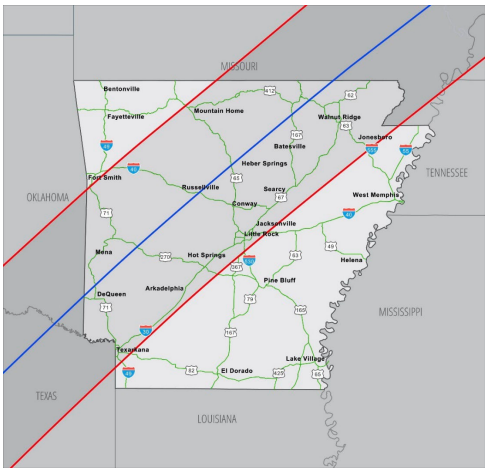The eclipse is coming: Are agricultural communities prepared?
Feb. 2, 2024
By the U of A System Division of Agriculture
Fast Facts:
- Approximately 1.5 million people expected to travel to path of eclipse
- Eclipse path estimated to be about 118 miles wide
- Will cross Arkansas from 1:46 p.m. to 2:00 p.m.
(638 words)
(Newsrooms: With map of eclipse path)
NEWPORT, Ark. — A tourism event unlike any other will be darkening the skies across Arkansas — and many other states in its path — in just a few months. And while the Great North American Eclipse will be something of an unescapable spectacle, rural and agricultural communities will likely see an influx of traffic as enthusiasts seek the open skies of farmlands.
On April 8, between noon and 4 p.m., the Earth’s moon will completely eclipse the sun for about four minutes over any given location in its path. For Arkansas, this will mean a shadow approximately 118 miles wide, stretching from the southwest corner of the state to its northeast corner. The shadow is expected to begin near DeQueen at 1:46 p.m., CDT, and exit the state at about 2:00 p.m. near Pocahontas, according to the Arkansas Department of Transportation.
People throughout the region are expected to flock to the path of totality, including agricultural areas such as Jackson County, Arkansas. Matthew Davis, staff chair for the Jackson County Cooperative Extension Service, recently appeared before the Newport Area Chamber of Commerce, urging its members to begin thinking about how best to prepare residents for the possible influx of motorists.
“The concern is that local, county and state two-lane highways typically used by sizeable farming equipment — sometimes exceeding 20-foot widths — will be potentially full of additional vehicles,” Davis said. “People using these less-trafficked roads as places to pull off to view the eclipse could be concerning to farmers with agriculture production starting at that time.”
“Up to 1.5 million people are expected to travel from outside the state into Arkansas, along with 500,000 Arkansans who will travel from their residences to the path of totality, for a total of 2 million people who will visit the viewing area,” according to an October 2023 report from ArDOT.
To prepare, Davis had recommendations for both motorists as well as farmers, many of whom will still be preparing fields and planting crops in April.
Here are a few things to consider when planning your routes as a farmer:
- Make sure the lights are legal and working.
- Hazard lights and slow-moving vehicle signage need to be visible.
- Proceed with caution when entering and exiting highways.
- Use "follow cars" with flashing lights to alert traffic.
- Verify that attachments are secured, lights are functioning, and equipment widths and heights are noted.
- If traffic stops, pull over, seek assistance, or remain until traffic clears.
- Limit equipment movement during the day of the eclipse. Move equipment to areas that would provide a full day of work without the need to move equipment if possible.
Here are a few things for drivers to consider:
- Slow down when approaching equipment.
- Watch for hand signs or turn signals.
- Refrain from attempting to overtake machinery by speeding past.
- Watch for flashing lights or slow-moving vehicle signage.
- Only pull out in front of slow-moving vehicles after verifying that the slow-moving vehicle is a safe distance away and the road is clear enough to do so. Large equipment cannot stop as quickly as a motor vehicle. Always be cautious and verify safe operating distances to maintain space between yourself and the machinery.
- Slow-moving vehicles may be unable to use the shoulders, and you should not expect them to use them.
- Share the road.
- Avoid stopping on shoulders or private drives.
Davis said he wanted to address the Newport Area Chamber of Commerce out of an abundance of caution, but that it should still be taken seriously.
“Undoubtedly, we will get through this event, and it will be a footnote in the history of Jackson County,” Davis said. “Even beyond the event, we need to maintain these safe practices as we cooperate with the farmers and industry of our area.”
To learn about extension programs in Arkansas, contact your local Cooperative Extension Service agent or visit www.uaex.uada.edu. Follow us on X and Instagram at @AR_Extension. To learn more about Division of Agriculture research, visit the Arkansas Agricultural Experiment Station website: https://aaes.uada.edu/. Follow on X at @ArkAgResearch. To learn more about the Division of Agriculture, visit https://uada.edu/. Follow us on X at @AgInArk.
About the Division of Agriculture
The University of Arkansas System Division of Agriculture’s mission is to strengthen agriculture, communities, and families by connecting trusted research to the adoption of best practices. Through the Agricultural Experiment Station and the Cooperative Extension Service, the Division of Agriculture conducts research and extension work within the nation’s historic land grant education system.
The Division of Agriculture is one of 20 entities within the University of Arkansas System. It has offices in all 75 counties in Arkansas and faculty on five system campuses.
The University of Arkansas System Division of Agriculture offers all its Extension and Research programs to all eligible persons without regard to race, color, sex, gender identity, sexual orientation, national origin, religion, age, disability, marital or veteran status, genetic information, or any other legally protected status, and is an Affirmative Action/Equal Opportunity Employer.
# # #
Media Contact:
Ryan McGeeney
rmcgeeney@uada.edu
@Ryan_McG44
501-671-2120
